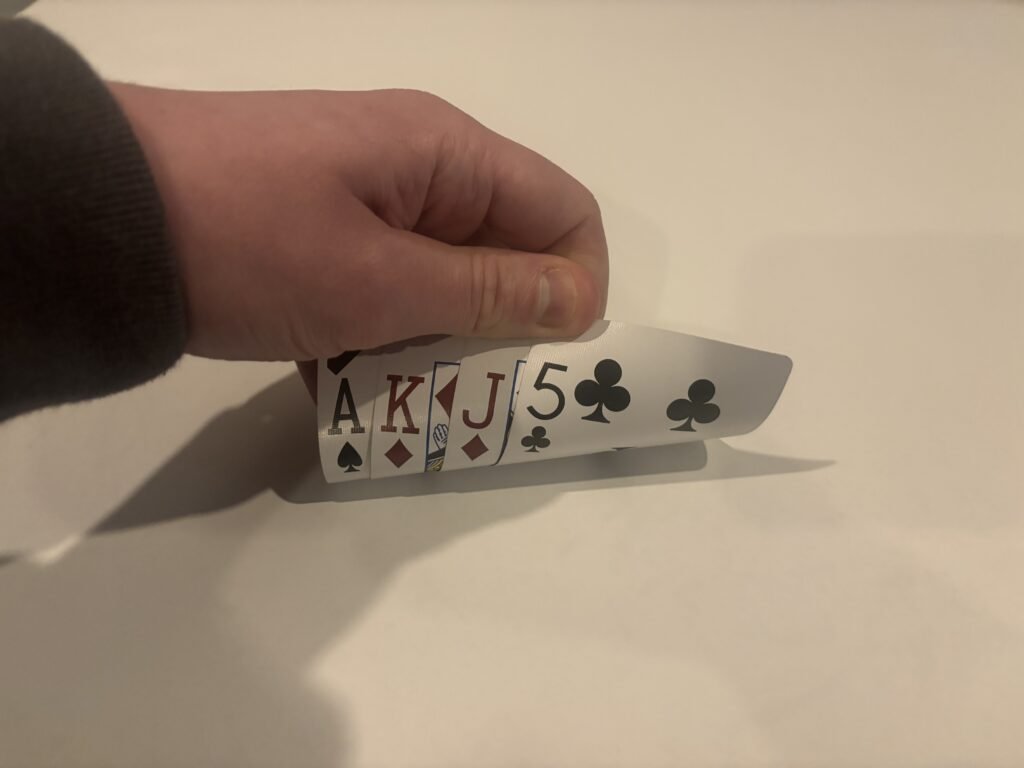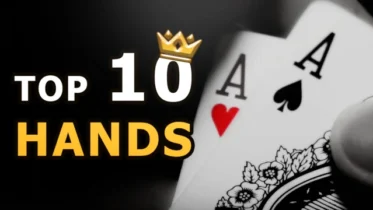Omaha Hi/Lo, often also referred to as PLO Hi/Lo or Omaha 8, is a variation of the classic game of Omaha poker in which the “Hi” and the “Lo” hand split the pot.
The game introduces an extra element of complexity to an already complex poker variation, making it a favorite game of many professional poker players.
If you have only ever played Texas Hold’em Poker before, jumping straight into PLO 8 may be a bit of a challenge, but if you have played the classic PLO game, you should not have too much trouble adjusting to the nuances of PLO Hi/Lo.
In both cases, it is worth looking over the rules of Omaha Hi/Lo from the ground up and making sure that you are not missing anything before you play.
In this guide to PLO 8 rules, we are going to cover everything from the basics of card dealing in the game to the way pots get split between high and low hands in this exciting poker variation, so let’s start at the very beginning.
Basics Rules of Omaha Hi/Lo
Before we jump into any of the more intricate PLO Hi/Lo rules, it is important to understand the basics, so we will start by explaining how the game is played and what your objective is.
The game of PLO 8 is played with a standard card deck of 52 cards and anywhere between two and nine players at the table.
At the start of each hand, all players are dealt four hole cards face down, with a further five community cards dealt across the table in three separate dealing “streets” called flop, turn, and river.
In all PLO games, players must use exactly two hole cards and three community cards to make up the best five card hand.
However, in PLO 8, you are allowed to use a different combination of hole and community cards for your Hi and your Lo hand as long as you can find the appropriate combinations from the cards at your disposal.
We are going to demonstrate how you can build your Hi and Lo hand in the same PLO 8 hand using different cards in an example later on, but for the time being, let’s go over the betting rounds and your playing options on each of the betting streets in the game.

Poker greats like Daniel Negreanu work to master all poker games, including Omaha Hi/Lo.
PLO 8 Betting Streets
Before a game of PLO 8 can start, the dealer must pick one player to assign to the dealer button. Once this is done, the players to their left post the small blind and big blind, the two forced bets that drive all further action.
Once the blinds are posted, the dealer deals out four hole cards to each player, which remain hidden for the remainder of the hand.
PLO Hi/Lo rules then dictate that each player at the table is allowed to act on their hand, starting with the player to the left of the big blind and ending with the big blind.
In total, there are four betting streets in PLO 8, and players get to act on their hands on each of these. The PLO 8 betting streets are:
- Preflop: First betting street played after the players receive their hole cards. Players can fold their cards, call the value of the blind, or raise the bet. The maximum bet and raise size depends on the betting limit in play (Omaha 8 can be played as a limit, pot-limit, or no-limit game).
- Flop: After the dealer deals the first three community cards called “the flop,” players get to act on their hands again. Players can check, giving action to the next player, make a bet up to the size of the pot, or raise any existing bet.
- Turn: The fourth community card is dealt, and once again, all players at the table get to act on their hands. On flop, turn, and river, the action starts from the small blind and ends with the dealer button.
- River: The final fifth community card is dealt, and there is no more dealing. Players take one last turn acting on their hand in the same manner as they would on flop or turn.
Once all the betting is done and the bets have been settled, the dealer announces the showdown, with players taking turns showing their hands. The last player who made aggressive action on the river is required to show their hand first.
The dealer will compare hands and look for both hi and lo hands. If at least one player qualifies for the lo, the pot will be split into two. If no one qualifies for the lo, the best high hand will win the entire pot.

The main difference between Omaha Hi/Lo and Hold’em is the number of cards you are dealt.
Player Actions in Omaha Hi/Lo
With each betting street in Omaha 8, players get to act on their hands in a number of different ways. While comparing hands at showdown is one part of Omaha Hi/Lo poker, the actions that precede showdown give room for poker players of all types to demonstrate their skills.
In order to be able to play Omaha 8, you will first need to understand all the different betting options you get to take in hand. So, here is a quick look at every option you have and a short description of how and when you can use it:
- Fold: This option allows you to throw away your hole cards and exit the hand. Once you have folded, you will not be given any further options and will not have a chance to win the pot.
- Bet: If there is no active bet in front of you, you may decide to bet. The minimum bet size depends on the betting limit. In limit Omaha 8, you will be able to bet one bet at a time, while in PLO 8 or NLO 8, you will be able to bet up to the size of the pot or up to the size of your entire stack, respectively.
- Raise: If there is an existing bet in front of you, you may decide to raise the size of the bet. In Limit Omaha 8, you will have to raise one bet at a time. In PLO 8 and NLO 8, you will be able to raise up to the size of the pot or up to the size of your stack respectively.
- Check: If there is no active bet in front of you, you may decide to check, passing the action to the next active player and not making any bets.
- Call: If there is an active bet or a raise in front of you, you may decide to call the bet. To call, you will need to match the size of the bet, and you will close the action if you are the last player to act.
- All In: If you make a bet or raise of sufficient size, you will be considered “all in.” You are all in when you have no more chips to make bets or call bets with. In such a case, your hand will always be active at showdown, but you will not be able to make further bets or play for any further chips that other players put into the pot subsequently.
Note that the order in which players take action on their hand in different Omaha 8 formats does not change, but the betting limit can.
Limit Omaha Hi/Lo uses preset betting limits that players have to use on each street. In this case, you can only make a fixed bet and raise this bet up to three times, in increments of one bet at a time.
In Pot Limit Omaha Hi/Lo, you will always be allowed to make bets or raises up to the size of the pot. So, if there is $100 in the pot, you will be able to bet $100. The next player, should they decide to raise, will be able to raise it up to $400, which is the size of the pot following your bet.
In No Limit Omaha Hi/Lo, there is no limit to the size of your bet. The only limiting factor, in this case, is the amount of chips you have on the table, as table stakes are the norm in modern day poker games.

Before putting your whole stack at risk,
make sure you have a hand that can win the Hi and the Lo.
Determining the Lo Hand in Omaha Hi/Lo
One of the most misunderstood elements of Omaha Hi/Lo, especially for new players, is the way the lo hand is determined and compared in the game.
For the HI portion of the pot, the game uses typical poker hand rankings, with hands like royal flushes, straight flushes, and four of a kind being the best. If you are not familiar with these, you can check out our guide to Pot Limit Omaha poker and find the exact hand rankings there.
For the lo portion of the pot, however, the game uses the Ace to Five hand rankings, which are not used in too many games these days and which take some getting used to.
For starters, you need to understand that only cards 8 or lower count towards the lo, and any higher card can never be part of the lo hand.
This means that you will need at least three unpaired community cards to be 8 or lower for lo to even be possible, as each Omaha hand must use three community cards and two hole cards.
Furthermore, you will need at least two hole cards to be 8 or lower, and those cards cannot be paired with the board cards, as pairs don’t count for a low.
If you do have a five card combination that qualifies for a lo (straights and flushes don’t matter), your hand will be compared against other lo hands.
The two hands will be compared from the highest card down, with the player whose highest card is lower always winning.
For instance, if you have 7♥6♣5♦4♣3♥, you will win against 8♦5♣4♥3♦2♠, as your 7 lo beats your opponent’s 8 lo regardless of the other cards.
If the highest card in two Lo hands is the same, the next highest card is compared until one player has a lower card and wins.

Have you seen my list of the Top Ten Poker Players To Watch in 2024!?
Omaha Hi/Lo (Pot Limit) Example
To demonstrate how the game of Omaha Hi/L o actually works, we are going to give you an example of a $2/5 PLO8 hand played in a live cash game.
With starting stacks of $500, we look down at A♥A♦2♥5♦, a great Omaha 8 hand that can win both the lo and the hi quite often.
Folded to us in the Cutoff, we raise it up to $15. The button, small blind, and big blind all call, making the pot $60.
With $60 in the pot the dealer puts out a flop of:
3♥4♥J♠
The blinds both check, and we examine our hand. We have a nut flush draw, a wrap to a straight, and multiple nut lo draws, giving us an amazing Omaha 8 hand.
We fire out a bet of $45 into the pot, which is called by the big blind only.
With $150 in the pot, the dealer burns and turns:
8♥
This perfect card gives us the nut flush and the nut lo. When the opponent checks to us, we bet $100 for value, and get called once again.
The river brings an inconsequential:
Q♠
The opponent checks once again, and with $350 in the pot, we bet our remaining $340 into the pot. After some time thinking about it, our opponent calls and shows us:
A♠J♥Q♥2♠
The player has two pair for hi, which we beat, winning half the pot right away. He also has As2s for the lo, which means we chop the lo half of the pot.
We win three quarters of the pot in this particular scenario, which is a fairly common situation in Omaha Hi/Lo and a big reason you should never be playing for just one half of the pot, especially the lo end, which is often chopped when the hand goes to the showdown in a big pot.



